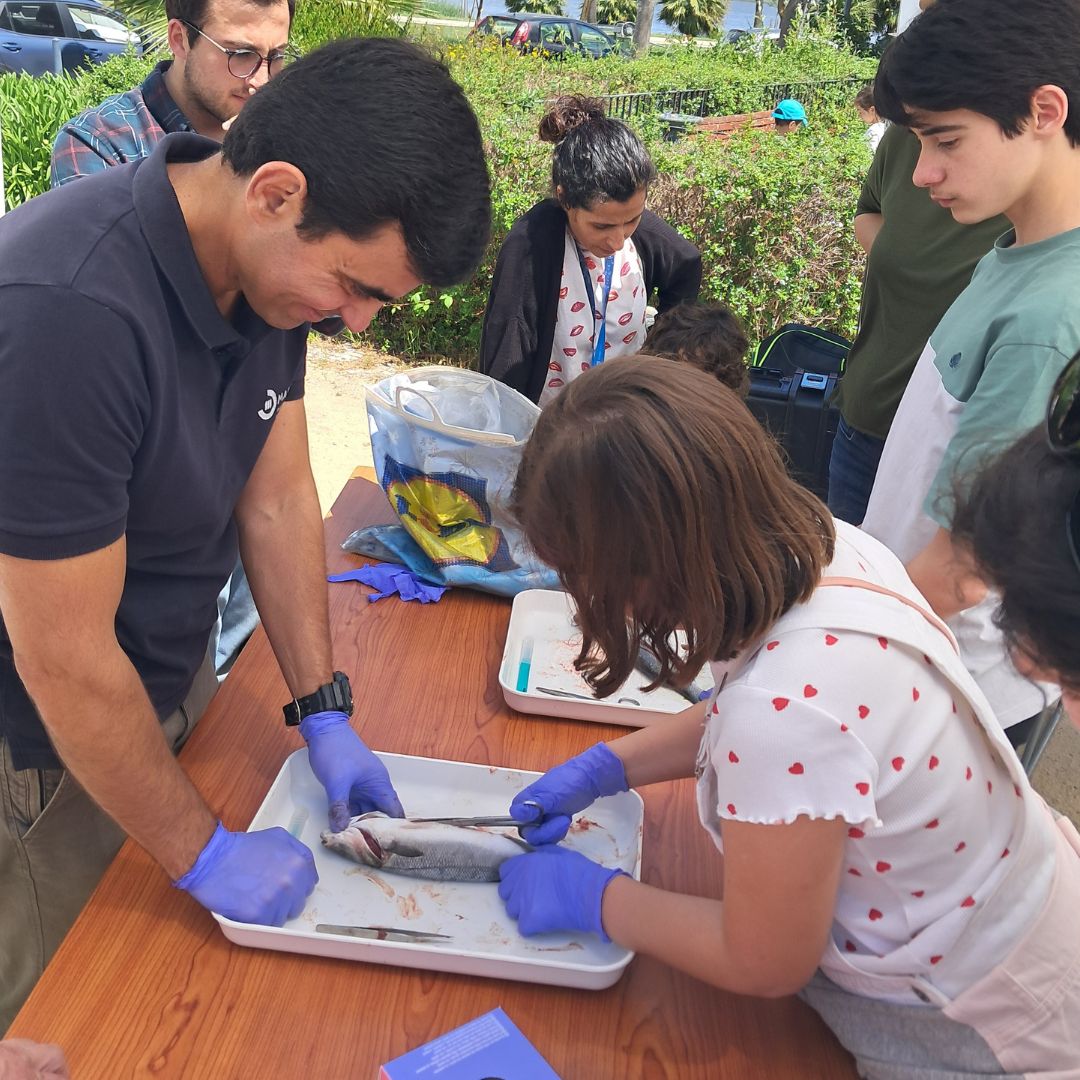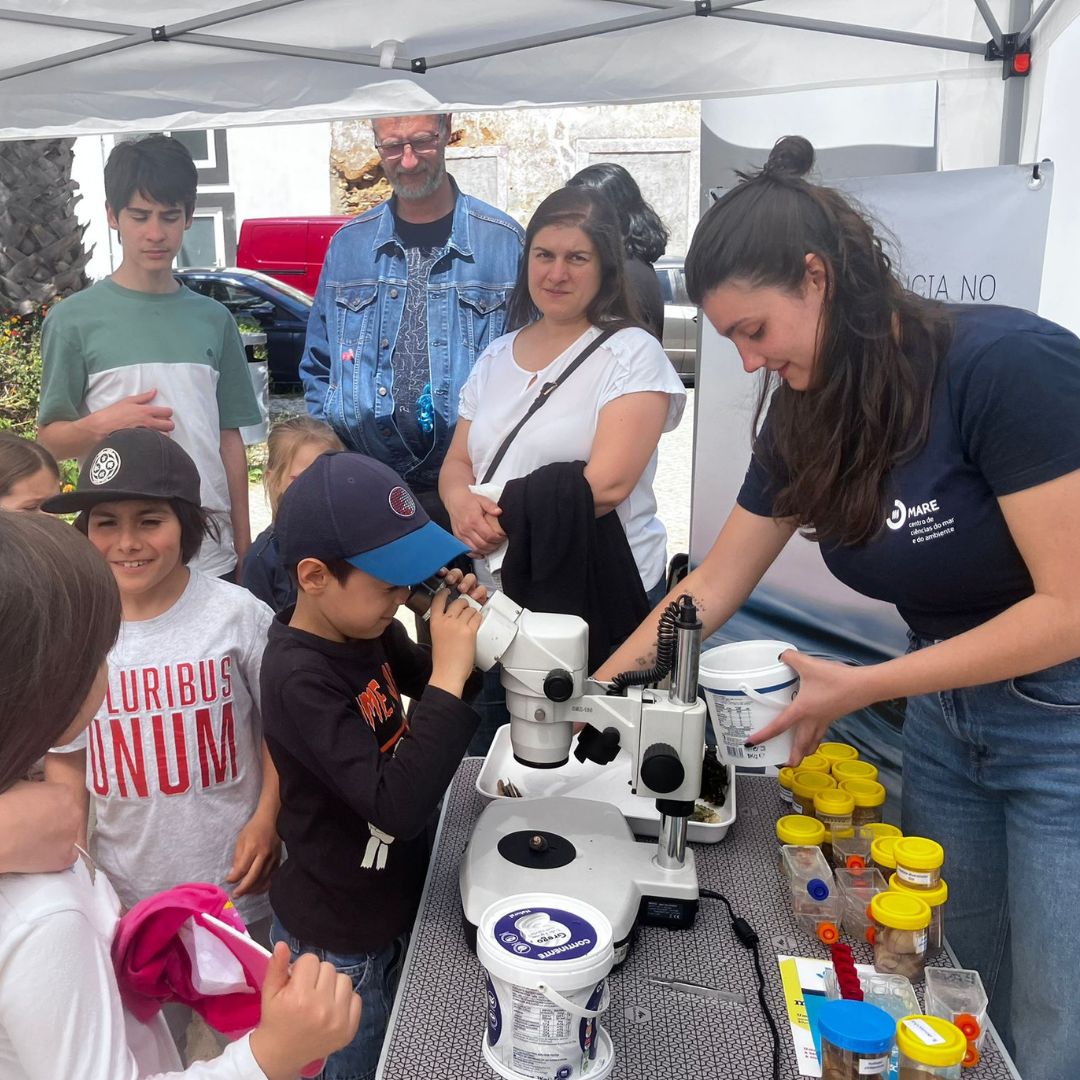Aquatic research brings together around 100 people on Alhandra's waterfront
On May 12, “MARE à Beira Rio” took place in Praça Soeiro Pereira Gomes in Alhandra. Researchers Filipe Ribeiro, Bernardo Quintella, Beatriz Castro, Christos Gkenas, Inês Pires, João Paulo Medeiros and Mafalda Moncada, from the Center for Marine and Environmental Sciences of the Faculty of Sciences of the University of Lisbon (MARE-ULisboa), carried out some educational activities for families. The aim of this initiative was to bring scientific knowledge closer to the community. 
“This event had four activities, one on the importance of 'mud bugs' in the estuary and river, another on how to study the movements of Tagus fish such as meagre and sea bass, another activity on invasive species in the estuary such as the Japanese clam and, finally, an activity on fish in the Tagus River, and specifically on the impacts of invasive fish such as the European catfish,” explained MARE researcher Filipe Ribeiro.
Over lunch, the participants were invited to try three invasive species that exist in the River Tagus. “The menu includes a carp pasta, river bream, fried rolls of siluro (European catfish) and fried slices of lucioperca with açorda,” said professional fisherman Carlos Serras, who added: ”There are thousands of these fish, especially in the International Tagus region.”

“The consumption of invasive fish can help reduce the impact of the European catfish on several native species in the Tagus River and, at the same time, provide some income for professional fishermen,” commented researcher Filipe Ribeiro, who stressed that ”last week's national record catch of this invasive fish in the Tagus International Natural Park in Castelo Branco is no surprise and we're going to see more records. Professional fishermen catch more than a ton of this invasive species in a week's fishing. Does it make sense to have a Natural Park full of invasive fish?” According to the researcher, the LIFE-PREDATOR project will implement the removal of European catfish in protected areas, reducing the impact of this invasive fish.
Over the course of the day, around 100 people attended the event, mainly families with several children. João Fernandes, a resident of Alhandra, said: “It was a very interesting activity for kids and adults. Our son really enjoyed handling the crabs and looking for the fish marked with the telemetry antenna. The experts are very approachable”.
Catarina Alexandre, a resident of Vialonga, commented: “The activity on river fish was very interesting for the whole family. There was a brief history of some of the river fish in our territory, as well as educational games. At the end, there was a divine lunch of roe açorda and fried fish”.
Dulce Domingos, from Gentes em Alhandra and Casa das Estórias, said, “I've never tried these invasive fish before! They were great, especially the siluro sea bream!”. Visitor Filipa Macieira added: “The gastronomic experience was great. We tried delicious dishes with river species. I loved the açorda and I'd never tried catfish before. It was very good.
For our researchers, the event proved to be a very positive experience. “It's always a pleasure to see - and renew - people's enthusiasm for the nature that is close to them and so often goes unnoticed. Invasive species have already entered - silently but devastatingly - into the lives of each and every one of us, especially in our rivers. It is urgent that everyone awakens the curious within them and tries to get to know the world around them better. Then you'll see that everything has to do with you and that an afternoon spent enjoying a wonderfully cooked siluro with friends and family can be a way of protecting our rivers, today and tomorrow,” says MARE researcher Mafalda Moncada.
MARE à Beira Rio” was an event organized by the Centre for Marine and Environmental Sciences of the Faculty of Sciences of the University of Lisbon, the Associação Gentes em Alhandra, Casa das Estórias and the Parish Council of Alhandra and São João dos Montes.
Text by Filipe Ribeiro in collaboration with MARE's Communication Office
